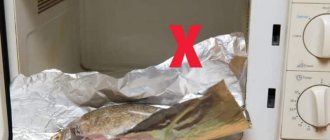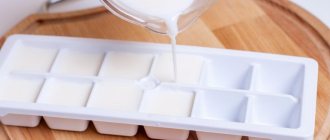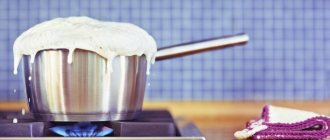If we are talking about cow's or goat's milk, then, despite the occasional warnings about the dangers of heating milk in a microwave oven, the answer is yes. However, on the question of whether it is possible to heat breast milk and baby food in a microwave, opinions are divided almost equally. Supporters of heating refer to common sense and the statements of Professor Komarovsky, while opponents rely on the results of little-known studies.
As for the harm that is attributed to microwaves, one rule applies: heating in a microwave oven is no more harmful than other methods of heating food, and most likely the opposite. The main thing is not to overheat the food and set the time correctly. According to the logic of microwave opponents, food heated in a microwave oven is “dead” because it is subjected to heat treatment. But in the microwave it is the smallest! Draw your own conclusions.
What to store in
You can store it in the bottles you used to express it. But this is only if you have a sufficient supply or the milk is used almost immediately. You can also pour it into glass jars, for example, from baby purees or juices. But before that, you need to sterilize the containers and dry them thoroughly. They are only suitable for storage in the refrigerator. For the freezer, it is better to use disposable bags. They are more practical, airtight and sterile.
Each container must be dated and timed. This will allow you to use milk on time and not give your baby expired milk. This is also done in order to understand at what time it separates more.
You can store at room temperature for 6 hours if it does not exceed 28 degrees. If the apartment is cool, up to 22 degrees, then you can store it for 8-10 hours. In the refrigerator, the shelf life can last from 4 to 8 days. The longest period is in the freezer. There it can lie for up to 3 months, and in the extra-frozen compartment - 6-12 months.
Can milk be heated in the microwave?
A microwave helps heat food quickly. At the same time, water and its molecules begin to actively move, releasing energy. As a result, the food heats up. It is very convenient to heat infant formula and breast milk. But is it really safe? Can you heat breast milk in the microwave?
Breast milk is a valuable dairy product. Formed when women begin lactation. Contains proteins, vitamins, minerals, antibodies necessary for the development of the child and protecting him from infections. Breast milk enters the baby's body in a heated form and is at the mother's body temperature. However, there are times when you need to pump milk to get away for a few hours.
For heat treatment of milk cooled in the refrigerator, many people use a microwave oven. But this is unsafe for the baby's health. Under the influence of electromagnetic radiation, spot heating of the product occurs. This leads to destruction (complete destruction) of protein molecules and antibodies of a protein nature. If you do not adhere to certain heating rules, there is a risk of converting amino acids into toxic isomers, which will negatively affect the child’s body.
Breast milk heated in a microwave oven loses its beneficial properties and can be harmful. It cannot be heated in the microwave.
Food does not heat evenly in the microwave. There is a risk that the dairy products and mixture will heat up in parts. If you do not shake the liquid well before serving and do not measure its temperature, the child may burn the mucous membrane of the mouth.
Cow's milk
Cow's milk should be given to children after one year of age. It cannot be used as a supplement or a substitute for mother's milk or formula. A newborn cannot absorb cow protein or fully process milk components.
The daily intake of cow's milk at the age of 1 to 3 years is 2-3 glasses, after 3 years - as much as the body requires. Cow's milk, especially those purchased at the market, should be boiled before consumption.
This is important to do, as it may contain dangerous bacteria that can cause serious illness. As a result of boiling, most protein molecules, vitamins, and minerals are preserved
Some people boil milk in the microwave, but with this processing method, more nutrients are lost than with regular boiling and pasteurization. You can use microwave ovens to heat the product, but heating will be uneven.
Goat milk
Goat milk contains less casein protein, which is difficult to process, and more vitamins. Goat protein practically does not cause allergies. Milk can be given as early as 9 months, and supplementary feeding of the baby if the mother’s lactation is poor
It is important to boil before eating. Do not do this in the microwave
You can use a microwave oven for heating if you follow the rules and select the right dishes.
The best heat treatment method is a water bath.
Can the mixture be heated in the microwave?
Each mother decides for herself whether to heat the mixture in the microwave. Electromagnetic radiation changes the structure of food, it becomes harmful. But some people believe that microwave ovens are safe. It is better to use the microwave as little as possible and use safer heat treatment methods. When artificial feeding:
- prepare the mixture before using it;
- Sterilize bottles every time;
- Do not reheat baby food;
- Discard the remaining mixture after eating.
Does the mixture need to be heated?
But where does the question even arise, is it possible to heat the mixture in the microwave? Indeed, in most cases, such a product is sold in the form of a powder, which is diluted with water. The simplest and most obvious option is to dilute the required amount of the mixture with water at the desired temperature. However, in practice everything is not so simple:
- The child has eaten a very small part of the prepared mixture, and after a short time he may become hungry again;
- Mom and baby went for a walk, and the mixture cooled down;
- The bottle that we took with us on the plane has already cooled down, and there is no way to prepare the baby food again;
- To save money, the parents put the bottle with the remaining formula in the refrigerator.
Of course, it is better to prepare immediately before feeding the amount of formula that the baby eats at one time, so that there are no doubts about its heating and storage. But situations may be different, so it is better to find out in advance whether the mixture can be heated. Most doctors believe that this can be done if the finished mixture has been stored in the refrigerator, but not more than a few hours in a hermetically sealed bottle.
Is it harmful to heat food in the microwave?
There are various theories and speculations surrounding microwave ovens that cast doubt on their safety. It is difficult for an ordinary person who understands kitchen appliances only at the user level to determine what is true and what is false. This causes many to refuse to use a convenient device.
Today, people's opinions regarding heating food in the microwave are almost equally divided:
- one part believes that there is no harm in such a technique, moreover, food from a microwave oven is healthy, as it cooks quickly, which means it does not lose useful vitamins and microelements, does not contain harmful fats and other substances that are not beneficial for the body;
- the second believes that microwaves negatively affect the condition of the product and residual radiation is present in heated food and enters the body.
The benefits of food cooked or heated in a microwave oven can be debated. And when it comes to children, doubts arise even more often and a difficult choice arises between convenience and safety.
Advantages of the heating method
The current pace of life does not leave time for calm and measured completion of the process. And young parents are constantly in a hurry to get somewhere, trying to see as much as possible in life. Therefore, they see more advantages than disadvantages in using a microwave oven to heat milk. The positive features of the device include:
- fast heating of food;
- ease of use;
- comfort and convenience.
However, no adult is confident in the safety of using a microwave to heat milk. Therefore, until there is a complete guarantee, it is better not to take risks and use proven methods.
Features of storing and heating breast milk
Breast milk contains elements important for the baby's development: oligosaccharides, beneficial bacteria, antibodies and proteins. In order to preserve them to the maximum, you should familiarize yourself with the specifics of its storage and heating.
There are several options for storing breast milk:
- room storage conditions;
- chilled look;
- frozen state.
Room storage conditions depend on temperature. If it is from 18 to 21 ºC, expressed milk should be stored for 6 hours, and in the case of a constant average temperature of 23 to 25ºC - no more than 3 hours. In the refrigerator, expressed milk remains healthy for a week.
The nutritional properties of milk are preserved, but the immune benefits are partially lost if it is stored frozen. However, it still remains more useful than factory-made infant formula. In the freezer compartment, at temperatures down to -16 ºC, the shelf life is up to 3 months, and at temperatures up to – 19 ºC, up to 6 months are possible. Be sure to indicate the freezing date.
Regardless of the storage method chosen, it is important to choose the right container. Which, when heated and cooled, does not affect the composition of the product
Conditions for choosing containers:
- sterility;
- presence of a measuring scale;
- Tight screw cap.
The required container can be easily found at a pharmacy or specialty store. For storage in the freezer, it is convenient to use specially designed bags and containers. They are not damaged by freezing and have a measuring scale. The downside is the high cost and the fact that the bags cannot be reused. Do not forget to sign the date of expression of the product in order to comply with shelf life.
The shelf life of food is significantly influenced by sterilization of containers. If reusable containers are used, they must be sterilized before each use. To do this, you need to heat the water to a boil. When steam appears, hold the storage container over it for 3 - 5 minutes. Lids should also be sterilized. Some modern heating appliances are equipped with this useful feature.
Once cooled and frozen, breast milk can be heated. To do this, you need to choose one of the methods: a water bath, running water or special electrical appliances.
The main thing is to follow the rules and sequence of preparing food for consumption:
- Frozen breast milk must thaw in the refrigerator before heating;
- do not expose the product to direct fire;
- re-freezing is not possible;
- expressed milk should not be boiled, maximum heating temperature is 37ºC;
- Before feeding, shake the filled container so that its temperature becomes uniform.
Rules for using the oven
In addition to selecting fuel, it is necessary to take into account other rules for using the stove in order to get the most out of it. For example, if you have been away for a long time, then you need to perform several steps before starting the kindling.
- Carefully inspect all brickwork. Over time, cracks or crevices may appear in it, through which, when fuel burns, carbon monoxide will leak into the room, posing a danger to human life. If you find such defects, they must be eliminated. For this, clay mixed with sand is taken. You need to carefully cover all the cracks with this mixture and wait until it dries.
- If there is ash left in the stove from previous kindlings, it must be removed.
- The outside must be wiped clean of dust, since when the structure heats up, it can cause an unpleasant odor. If the chimney needs whitewashing, whitewash it.
In addition, there are safety rules related to the regular use of both conventional and sauna stoves:
- Only specially prepared fuel can be used for kindling. It is strictly forbidden to throw household and construction waste into the firebox. This has already been mentioned above, but it is worth repeating. Plastic and various chemical spray cans are especially prohibited - when heated, these things either release substances hazardous to health or even explode, thereby creating a fire hazard;
- it is strictly forbidden to open the door to the firebox and the vent at the same time;
- fuel and other flammable materials must be located at a distance of at least half a meter from the stove;
- To avoid overheating of the stove, it can be lit only twice or thrice a day, and each run should take no more than two hours. This applies when wood is used as fuel;
- If the stove is used continuously, it is necessary to clean the chimney 2 or 3 times a month. This is necessary for high-quality removal of combustion products;
- Under no circumstances should you use various flammable substances for kindling: for example, acetone or gasoline. It may blaze so that the whole house turns into one big stove;
- If the family has small children or pets, the stove must be under constant supervision while the fuel is burning.
As you can see, the main part of the rules is aimed at protecting the house and the people living in it from possible dangers associated with the use of fire. If everything is carefully followed, the stove will bring you extremely positive emotions, making your home warm, cozy and comfortable. Good luck!
Melt the butter on the stove if you want perfect, evenly melted butter or if the recipe calls for frosting. If you want to save time, use the microwave, but follow the instructions provided to avoid heating too quickly or unevenly. Finally, if you just want to soften butter that has been stored in the refrigerator or freezer, you have many options, which we will cover in this article.
How to heat properly?
We are not talking about boiling a store-bought product; it already undergoes the necessary processing; you just need to monitor the expiration date. This is how you need to boil milk from under a cow so that it does not lose vitamins and nutrients:
- boil immediately upon returning home from the market;
- at a temperature of one hundred degrees, it is enough to heat the product for two minutes;
- at sixty degrees or more the time increases to ten minutes.
When the liquid heats up and foam begins to rise, you need to reduce the heat. You should not let the milk “run away” and burn. To obtain a thicker mass, the procedure is continued for half an hour.
To preserve the vitamin composition of the drink, you should cool it immediately. For example, place a hot pan in a bowl of ice water.
There are a few more points to consider when boiling:
- milk should be boiled in a glass, aluminum or steel pan; it is better not to use an enameled one;
- You can check the liquid for freshness by pouring a glass of water into the pan. As soon as it boils, add a glass of milk. If it has curdled, then you are dealing with a stale product. It is not suitable for consumption in its pure form. But if the milk has not curdled, then you can pour out the rest. A glass of water will evaporate from it;
- a saucer placed upside down on the bottom of the container will prevent the milk from bubbling and spilling over the edges;
- You need to heat the milk over low heat and stir occasionally. This way it will heat up evenly. It is recommended to remove the film before boiling, but not after, because useful substances accumulate in it.
It is up to the consumer to decide whether to boil milk from the cow or not. How long it was stored and when it was mined, the answer is ambiguous. A drink from a neighbor's cow may be healthier and tastier. But the prospect of poisoning with a low-quality product and contracting infections is much more serious.
Bibliography:
- Animal husbandry - Wikipedia
- Animal husbandry // Encyclopedic Dictionary of Brockhaus and Efron: in 86 volumes (82 volumes and 4 additional). - St. Petersburg, 1890-1907.
- Animal husbandry // Great Russian Encyclopedia: / Ch. ed. Yu. S. Osipov. — M.: Great Russian Encyclopedia, 2004—2017.
Myths about the microwave oven
The first microwave was released in 1947. The device was used by the military to defrost food. Later, scientists discovered that food was heated quite well in it. Since then, the microwave oven has been popular. You can quickly heat up food in it, and some people often cook in it.
Modern microwave ovens save time. The devices set the required temperature and processing time for the product. No need to use pots or light a fire. You can simply put food in the microwave for a few minutes and get a hot dish.
Over time, microwave ovens have become overgrown with myths. You can hear that the device turns food into a useless mass and kills all vitamins. Opponents of microwave ovens argue that the devices emit radiation and are dangerous to use. People are intimidated by stories about the mutation of foods that were cooked in a microwave oven. However, for more than 70 years, there has been no evidence that microwave ovens are harmful to health.
The device emits microwaves during operation. They activate water molecules. As a result, the product heats up. During processing, the composition, structure and properties of food do not change. Therefore, stories about the dangers of microwave ovens are nothing more than myths.
Myths about microwaves
Until now, even after a huge number of studies and tests, the results of which have been officially certified, colorful misconceptions about radiation, mutations and, at best, the uselessness of food after such processing are incredibly popular and widespread. And this is only a small part of the myths about the microwave.
There is also an opinion that any heat treatment is harmful to food, so there is no need to cook or heat it. There is, of course, some grain of truth in the latter, but only a grain. Some substances are destroyed during heat treatment, but this does not make the products “useless”.
How to heat milk
Experts from Miss Clean magazine recommend using a microwave oven both for heating liquids and for preparing other types of food - it is safe. But before heating the milk, you should read the instructions for the microwave oven: in most cases, there will be recommendations on what power and time it is better to choose so as not to overheat it, so that it does not “run away”.
General recommendations:
Before heating milk, be sure to read the instructions for your particular microwave. This will help avoid troubles with boiling over. Milk should only be heated in glass or ceramic containers. The exposure time should not exceed one minute. Under no circumstances should the container be covered with a lid. Milk and other liquids can only be heated in the microwave in open containers. It is strictly not recommended to heat milk and other liquids in plastic containers. Even one specifically designed for the microwave. It is worth remembering that liquids heat up faster in a microwave oven than other products
Therefore, greater caution is needed with them. Once the milk has been frozen, it should no longer be frozen. And before heating, you should let it thaw either on its own at room temperature, or in the longest/special defrosting mode, if the microwave model has one. It is recommended to heat any liquid in the microwave only once.
This will help maintain the bright taste of the product.
As for breast milk, you should not heat it in the microwave. But not at all because microwave radiation is harmful, but because it is desirable to completely eliminate any temperature effects on it, except natural ones. Then and only then will we talk about its undoubted benefits and safety for the child.
As a result, most of the so-called “facts” talking about the dangers of microwave ovens are far-fetched and replicated by the Internet and the media. And they have no evidence or research behind them. And there have been quite a few of the latter over almost 70 years of the existence of microwave ovens; finding the results will not be difficult, and they all indicate the safety of the device.
Alternative heating methods
There is no official data on the dangers and safety of heating milk in a microwave oven. However, if the published arguments why it is impossible to heat milk for a child in the microwave seem convincing, you should use safe methods:
- A water bath has long been used to warm expressed milk. To heat baby food using this method, you need to bring half-filled water to a boil in an enamel cup or saucepan. Then place a bottle of milk in it and heat it to the required temperature. The duration of heating is determined by the degree of cooling and lasts 2 – 7 minutes.
- If there is a hot water supply, the process is simplified. Place a bottle of chilled breast milk under running hot water and heat to the required temperature. To ensure that the contents are heated evenly, the bottle must be rotated. Do not use very hot water, as a sharp increase in temperature is accompanied by the breakdown of beneficial enzymes contained in milk.
- Baby food warmers are able to maintain the temperature at a given level without affecting the quality of the product. The stores offer models for simultaneously heating one or several bottles. The devices operate on the principle of a water or steam bath. In the second option, breast milk can be heated in a gentle mode. Depending on the model, the heating time is 2 – 10 minutes.
Video about whether microwave ovens are harmful:
How harmful are microwave ovens?
Watch this video on YouTube
What happens if you boil milk?
— When boiling, pathogenic microorganisms and lactic acid bacteria are destroyed. — Boiled milk
It is stored longer, but loses some of its beneficial properties.
... - Milk
cannot be boiled for a long time, you just need to bring the product to a boil and turn it off.
Interesting materials:
How long does it take to process a loan application at Sovcombank? How long does it take to process an application for Russian citizenship under the resettlement program? How long does it take to process a pension application? How long does it take to process a tax refund application? How long does it take to process documents for citizenship? How long does onion take to grow? How long does it take for onions to grow in water? How long can a child be without registration? How long can a child stay in a cocoon? How long does it take to register ownership of an apartment?
What foods should not be heated in the microwave and why. Why is this dangerous?
You can harm your health and get serious food poisoning, in the worst case. In others, products lose one hundred percent of their beneficial qualities and taste.
The microwave oven has become such an integral kitchen attribute today. With its help, we not only heat up, but also cook and defrost food. However, there are a number of products that still do not need to be heated in the microwave. On the stove please.
What happens to them when heated in a microwave oven and why they should not be heated so as not to harm your health, you will learn from this article.
Boiled and raw eggs (whole)
Many have tried to do this). Anyone who has tried it can give you advice not to repeat this experience. Why?
First -
This is the principle of operation of the device and heating. Whole raw eggs heat up inside, the temperature creates such pressure that the shell cannot stand it. As a result, the eggs explode.
Second -
If you decide to heat boiled eggs, it is better not to do this so as not to harm your health. The egg contains protein and proteins, the structure of which changes under the influence of microwaves. As a result, you can experience disruption of the gastrointestinal tract.
Meat (frozen)
Defrosting meat in the microwave is not advisable. The reason for this is quite serious.
Raw meat is a haven for various bacteria. When you put it in the microwave to defrost, they develop and multiply at an accelerated pace.
Taking such meat out of the oven, you can see that in some places the meat has changed color and darkened. In some places, the meat is already spoiled and simply teeming with various sticks and microbes. Such meat can not only spoil digestion, but also cause serious poisoning.
Proper defrosting is to place the meat in a bowl and fill it with water, and it is best to transfer it from the freezer to the refrigerator compartment on the bottom shelf in advance.
Milk
Having taken milk out of the refrigerator, many people pour it into a cup and put it in the microwave to warm up for half a minute or a minute. Better to pour it into a small saucepan and heat it on the stove. Why?
Milk heated in the microwave loses most of its beneficial qualities. Half of the beneficial substances from the action of microwaves change their structure and become useless, almost 90 percent of B vitamins are neutralized. That is, you will not get poisoning, but there is no benefit from such milk.
Cottage cheese, sour cream, yoghurts
This is especially worth considering for young mothers who like to quickly warm up yogurt or cottage cheese for their baby. I would like to warn against this for two reasons.
Firstly
– radiation destroys all the beneficial qualities of the product, beneficial substances are modified and become useless.
Secondly.
The same waves neutralize milk and bifidobacteria necessary for intestinal microflora and digestion.
Third.
Plastic containers will not melt, but at elevated temperatures they release volatile substances that make up plastics. Of course, they end up in the product and then in the human body.
Fourth.
Part of the product curdles, and as a result, healthy and tasty curds and yogurt lose not only their benefits, but also their taste.
Natural bee honey
Honey generally does not like elevated temperatures. When heated above 40 degrees, it loses up to 85% of its beneficial properties, and with stronger heating, some substances are converted into harmful to health.
You can heat honey (so that it becomes liquid) without exceeding a temperature of 40 degrees. The temperature in a microwave oven is much higher.
You can melt honey by making a water bath. You will spend twenty minutes longer, but will retain the taste and unique beneficial properties of the natural product.
Rolls, sushi
The rolls, beloved by many, with different fillings, have a very short shelf life, not exceeding two hours, during which time they must be consumed.
Most of them are made with fish: salmon, tuna, salmon. and other seafood.
When heated in a microwave oven, like meat, harmful microorganisms begin to develop and multiply. Reheating sushi or rolls in a microwave oven can, at best, cause indigestion, and at worst, lead to severe food poisoning. By the way, it is poisoning from fish and seafood that is considered the most dangerous.
/==========================================/
I hope you were interested and the article was useful. I wish all my readers a good mood)
How does an oven actually work?
The main aspect that causes concern among housewives is the very principle of operation of microwaves. After all, a microwave oven does not heat food convectively, that is, from hot air or dishes to cold food upon their contact. The operation of a microwave oven is based on a more complex process that you need to understand before sounding the alarm and throwing the unit out of the house.
Without going into details, which are easy to find in any physics textbook, ultrahigh-frequency radiation causes the water molecules themselves (and not only) to move faster, as a result of which the products heat up. And there is nothing unnatural in this movement; accordingly, it cannot radically change the properties of food, much less the structure of water. In any case, no more than heat treatment by any other method. And there is no talk of radiation at all - it simply has nowhere to come from.
Why does milk take a long time to boil?
It's all about chemistry. In addition to water, milk contains so-called long polymer molecules. When the milk heats up and the water evaporates from the upper layers, these molecules stick together and form a strong film.
Interesting materials:
When does the traffic sign begin? When should you have a bachelor party? When should you not do permanent eyebrow makeup? When should fluorography be done? When should a blind area be done? When should you do the first maintenance? When the orchid has faded, what should I do next? When does Oblivion take place? When does the novel The Master and Margarita take place? When does The Night Before Christmas take place?
Is it possible to heat food for children in the microwave: how to decide?
10.10.2016
Since the functional and practical kitchen appliance called a “microwave” entered the life of every modern person, the existence of many people has changed for the better.
Firstly, it is convenient: in order to prepare and, especially, reheat a dish, no special skill or culinary knowledge is required. Secondly, it is more practical than, for example, using a frying pan.
And, finally, it’s economical - not only in terms of energy saving, but also saving personal time if you need to go somewhere urgently, and it wouldn’t hurt to eat. However, there is one small “but”: today everyone who is not too lazy is talking about the unimaginable harm of microwave ovens.
Therefore, young parents began to wonder: is it possible to heat food for children in the microwave? Do foods prepared this way really lose all their vitamins and nutrients? We will try to thoroughly understand these and other nuances.
"Yes or no"?
Let's start with the fact that opinions about current microwave ovens are diametrically divided.
The first category of people, consisting of adherents of this technique, believes that the food prepared there is no less useful than that which was created in the usual “old-fashioned” way, because it does not retain any residual radiation.
However, again, there is a “fly in the ointment”: not everyone is inclined to say so beautifully, to say the least: the absolute safety of microwaves is nothing more than an advertising ploy by manufacturers. And one can really argue about the benefits of food prepared there. But we are talking about the health of children, which under no circumstances should be risked.
Microwaves and breast milk
The answer to the question regarding heating breast milk for a baby in a microwave oven is definitely categorical. And it sounds negative. Any manipulations with expressed milk with the participation of this miracle of technology are not possible.
The explanation is simple: microwaves affect the living components of mother's milk, in particular immunoglobulins, which leads to two results: either cell death or a change in structure. Neither one nor the other effect can be called acceptable. Any kind of milk will come out of the oven, but not breast milk, which can be fed to the baby.
Therefore, it is better to use more gentle methods - gradual heating or using a “water bath”.
What about baby food?
If we talk about baby food, pediatricians do not recommend processing food in a microwave in any way, if only for the reason that the manufacturers of household appliances in this category themselves do not indicate in the instructions information about using the unit in this way.
But if this argument can still be called insignificant, then more categorical experts insist on another aspect.
This is not to say that food becomes very harmful (many scientists talk about the release of carcinogens). And the fact that nothing useful remains in it due to the creation of areas with high temperatures, which destroy useful substances, can be said with absolute certainty.
To be or not to be a microwave: how to make a decision?
As can be seen from the above, the scales “pros” and “cons” are almost equal
Therefore, before you decide whether to heat your child’s food in the microwave or still abstain, and also correctly assess the benefits and risks, pay attention to the following facts:
- The theory about cancerous tumors arising due to exposure to microwave ovens still has no official confirmation at the scientific level. But the opinion about absolute harmlessness, which the famous pediatrician Komarovsky speaks about, is also far from being as transparent as we would like.
- Microwaves act on the water in food, causing the molecules to rotate at enormous speeds. It is for this reason that food is cooked in the microwave almost at lightning speed. Therefore, if you decide not to do without the convenient results of technological progress, ensure that your food is heated correctly. Do not “charge” the unit immediately “to the fullest”: heat the product at low power for half a minute, mix it thoroughly, then continue the process, again for a short time. After this, be sure to check whether the food is ready by leaving it alone for a few moments. Only after this can food be given to the baby.
- Microwaving should not become a daily habit. If you have free time, use regular cooking methods, resorting to quick heating only when absolutely necessary - and then your kids will always be happy and healthy.
Does heating affect the beneficial properties of human milk?
Heating, if done incorrectly, greatly affects the constituents of mother's milk. For this reason, it is not recommended to boil the product even after freezing. Some women sterilize their own milk during infectious diseases so as not to infect the child, but this gives the opposite result. When exposed to high temperatures, the benefit of immunoglobulins, which could help the infant’s immune system cope with the causative agent of the disease, is lost.











